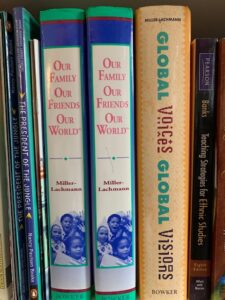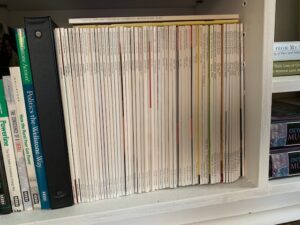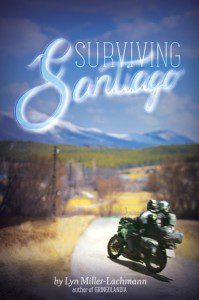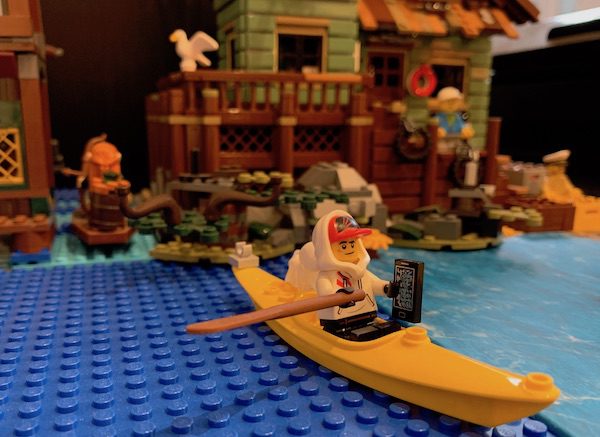A Change of Course (with Writing Advice)
 I didn’t always write fiction. After losing a contract for a YA novel many years ago, I decided to take a sure thing — an offer on a nonfiction proposal — instead of trying to revise and submit to other publishers the novel that came so close. That nonfiction proposal became Our Family, Our Friends, Our World: An Annotated Guide to Significant Multicultural Books for Children and Teenagers. It was my first traditionally published book, and it became a mainstay of library acquisitions and reference in the 1990s. After the book won a major award, I partied like it was 1995, becoming the author or co-author of two other reference books and a textbook as well as the editor-in-chief of MultiCultural Review. I stopped writing fiction. After all, I was writing to be read, and I had a growing and appreciative readership for my nonfiction.
I didn’t always write fiction. After losing a contract for a YA novel many years ago, I decided to take a sure thing — an offer on a nonfiction proposal — instead of trying to revise and submit to other publishers the novel that came so close. That nonfiction proposal became Our Family, Our Friends, Our World: An Annotated Guide to Significant Multicultural Books for Children and Teenagers. It was my first traditionally published book, and it became a mainstay of library acquisitions and reference in the 1990s. After the book won a major award, I partied like it was 1995, becoming the author or co-author of two other reference books and a textbook as well as the editor-in-chief of MultiCultural Review. I stopped writing fiction. After all, I was writing to be read, and I had a growing and appreciative readership for my nonfiction.

A complete run of the MultiCultural Review issues that I edited over 16 years.
I returned to fiction when I found myself completing my son’s middle school creative writing assignments, not because he asked me to do his homework but because I felt stifled creatively. After playing around with The Sims for a few months — at one point, he and I invited some new sim neighbors over, only to have them drown in our pool because we’d failed to install ladders — I decided to give the fiction writing one more try. I basically had to start over because I’d forgotten the craft basics in my time away. Three years later, I had a much-revised novel that sold to a publisher, a story that I’d tried to write 20 years earlier in graduate school and wouldn’t let me go after all those years.
 Since then, I’ve written YA and middle grade novels and picture books, some of which found publishing homes and many more (especially the picture books) that didn’t. I’ve learned things about “books of the heart.” All of the full-length novels I’ve written to the end, except one, have been books of the heart. You may say that you can have only one book of the heart, but every one of my novels has reflected my deepest feelings at the time, my understanding of myself and the world around me. For example, Dirt Cheap is the 20-year-old story that wouldn’t let me go, and Rogue was my way of coming to terms with myself and my past after I received my autism spectrum diagnosis as an adult. The “exception that proves the rule” was Surviving Santiago, the companion/sequel from little sister Tina’s point of view that my editor at Curbstone requested when he accepted Gringolandia for publication. Surviving Santiago, romantic suspense that draws on the conventions of the Latin American detective novel, was the most fun of all my books to write for two reasons. It already had a home (I thought), so I didn’t feel like I was writing into the void. And while I put a lot of myself into the story — particularly in Tina’s sense of bewilderment and dislocation as a stranger in the land of her birth — I wasn’t trying to pour my deepest feelings and beliefs onto the page but rather to tell a story that my readers would enjoy.
Since then, I’ve written YA and middle grade novels and picture books, some of which found publishing homes and many more (especially the picture books) that didn’t. I’ve learned things about “books of the heart.” All of the full-length novels I’ve written to the end, except one, have been books of the heart. You may say that you can have only one book of the heart, but every one of my novels has reflected my deepest feelings at the time, my understanding of myself and the world around me. For example, Dirt Cheap is the 20-year-old story that wouldn’t let me go, and Rogue was my way of coming to terms with myself and my past after I received my autism spectrum diagnosis as an adult. The “exception that proves the rule” was Surviving Santiago, the companion/sequel from little sister Tina’s point of view that my editor at Curbstone requested when he accepted Gringolandia for publication. Surviving Santiago, romantic suspense that draws on the conventions of the Latin American detective novel, was the most fun of all my books to write for two reasons. It already had a home (I thought), so I didn’t feel like I was writing into the void. And while I put a lot of myself into the story — particularly in Tina’s sense of bewilderment and dislocation as a stranger in the land of her birth — I wasn’t trying to pour my deepest feelings and beliefs onto the page but rather to tell a story that my readers would enjoy.

My experiences with TORCH and MOONWALKING helped me see it was time to change course.
Ever since I first started writing Dirt Cheap in 2000, I believed that the best books I wrote were the ones most meaningful to me. I maintained this feeling through Gringolandia and Rogue and through the two YA manuscripts I wrote after Rogue that never sold and that broke my heart when they never sold. I still believed it when I wrote TORCH and reentered the query/submission trenches after my longtime agent retired. But in the course of submitting the finished draft of TORCH and the proposal of MOONWALKING, and seeing levels of editor interest that I’d never encountered before, I learned something important. In addition to thinking about what my books mean for me, I need to think about what they mean for my reader.
This does not mean I have to “write to the market,” which can easily turn into a bad volunteer job, as my friend Laurie Morrison pointed out in a guest post on this blog. It does mean that when an idea grabs me and doesn’t let me go, I need to ask myself some questions: Why this story, and these characters? How do they add to someone else’s understanding of the world? How can my story change readers, and help readers change the world around them? How do I meet readers where they are — which is not always where I am?

Like my kayaker, I need to take into account who’s coming with me on the journey.
A few months ago, I returned to writing picture books after years of failing to sell quite a few of them and having an editor tell my old agent I didn’t have the sensibility to write them. After listening to my daughter, a skilled and passionate teacher of kindergarten and first grade, I became more aware of how young children respond to picture book texts. I learned how to visualize scenes and leave room for the illustrator to depict action. I also returned to my nonfiction roots, choosing real-life protagonists like the ones in my fiction for older readers. Bringing their desires and struggles to the fore played to my skills and interests far more than coming up with clever plot lines and twists to delight young children.
The turning point came when I took an outstanding online class at The Writing Barn, “Picture Book Bios That Breathe” with master writer and teacher Nancy Churnin. In addition to her presentations on the elements of successful picture book biographies, she read multiple drafts of our manuscripts and offered valuable suggestions. I highly recommend this class the next time she offers it. In the course of the six-week class, Nancy talked about her first efforts at writing picture book biographies and how she, as a journalist, didn’t understand that the chronological birth-to-death approach wasn’t helping her books sell. Classes gave her the keys to finding an agent and selling her work. Her class gave me a greater sense of what readers of picture book biographies — children, parents, and educators — want. What compels them to turn the pages, read the book over and over, and use the back matter to learn more and take action.
I’m enjoying this new direction, writing for a younger age group and hunting for the facts and stories that will appeal to them. For me, one of the most rewarding aspects of being a writer is growing in skill and range with each new project. Children are always learning, and we should be too!







Fascinating article, Lyn. Thanks for sharing your story. I feel like I am on a similar journey as a writer- though not as a published one.
You do make me think. A few articles back, you shared thoughts on racism that caused me to react with white righteousness. So amazing to watch all this thrown in my face when the Black lives matter movement erupted. I am currently working through Layla Saad’s book, me and white supremacy. So much to learn! Thanks.
Thanks for sharing the twists and turns of your journey. It’s encouraging to know that it is possible to write across many genres and ages, as long as you do the work of understanding what those different readers require. Second the recommendation for Nancy’s class!
Hi, Lyn. I’m always pleased to read your blog posts, but this time you brought back powerful memories about the many times your life and mine have intersected. As soon as they were published, I was honored to have been able to review GRINGOLANDIA and SURVIVING SANTIAGO, and I’ve enjoyed DIRT CHEAP (your first novel) and ROGUE, your most current. Along with all of those on my “Lyn” bookshelf is OUR FAMILY, OUR FRIENDS, OUR WORLD (one of the first multicultural anthologies). And next to it is a complete set of MULTICULTURAL REVIEW, which you gifted to me when I needed them (emotionally) most–and to which I refer often.
Besides the joys of new grandmahood, the work you’re doing now is so, so important; not the least of which his mentoring “up-and-coming” writers. Don’t stop.
Stay well. Be safe.
Virtual hugs,
Beverly